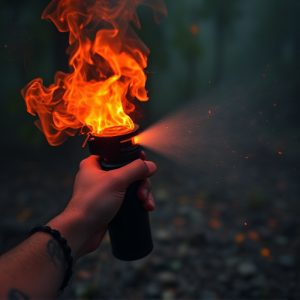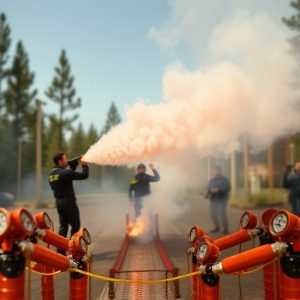Law Enforcement Guide to Wildfire Pepper Spray: Applications for Protection and Surveillance
Wildfire pepper spray is an indispensable tool for law enforcement, offering a non-lethal means of …….
Wildfire pepper spray is an indispensable tool for law enforcement, offering a non-lethal means of incapacitating assailants and controlling crowds. Its active ingredient, capsaicin, causes intense irritation to the eyes, skin, or respiratory system upon contact, allowing officers to manage potentially violent situations without resorting to lethal force. This precision-engineered spray is designed to reduce drift and deliver a controlled dose for effective distance management, ensuring the safety of both law enforcement personnel and bystanders. It's particularly useful in complex scenarios like public demonstrations or active shooter situations, and its use requires specialized training due to its heightened potency in environments like wildfires. Law enforcement agencies must incorporate environmental considerations when deploying the spray in these conditions, planning evacuation routes and coordinating with firefighting teams to avoid interfering with fire suppression efforts. Regular training updates based on the latest research are crucial for maintaining its safe and effective use across various situations, cementing wildfire pepper spray's role as a critical component of modern law enforcement's non-lethal arsenal.
wildfire pepper spray has emerged as a critical tool for law enforcement agencies, particularly in the context of wildfire management and public safety. This article delves into the multifaceted applications of this non-lethal defensive mechanism, offering insights on its use during wildfires and its role in deterring threats. We explore its scientific composition, effectiveness, and strategic deployment. Join us as we examine the pivotal role of wildfire pepper spray in modern law enforcement arsenals, ensuring preparedness and safety for both officers and communities amidst the unpredictability of natural disasters.
Understanding Wildfire Pepper Spray: A Comprehensive Overview for Law Enforcement
Wildfire pepper spray represents a critical tool in the arsenal of law enforcement agencies, particularly for crowd management and de-escalation situations. This potent formulation is derived from capsaicin, the active component found in chili peppers, which induces an intense irritant effect upon contact with the eyes, skin, or respiratory tract of an individual. The effects are temporary but profound, rendering an subject incapacitated without causing long-term harm. Law enforcement personnel must be thoroughly trained in its application to ensure its effective use in a variety of scenarios, from maintaining public order during protests to managing confrontational situations where traditional methods may escalate the threat level.
The deployment of wildfire pepper spray is strategically significant as it offers a non-lethal alternative that can effectively control and manage aggressive or combative subjects. Its application is governed by strict protocols and guidelines, emphasizing the protection of both law enforcement officers and members of the public. The formulation has been designed to minimize windborne drift and to have a targeted delivery system, which ensures its efficacy while reducing the risk of unintended exposure to bystanders. Understanding the nuances of wildfire pepper spray is crucial for law enforcement to effectively integrate it into their operational strategies, thereby enhancing public safety and maintaining order in dynamic and challenging environments.
The Science Behind Wildfire Pepper Spray: How It Works and Its Effectiveness Against Threats
Wildfire pepper spray is a specialized formulation designed for law enforcement to mitigate threats through non-lethal means. Its active ingredient, capsaicin—derived from chili peppers—induces an intense burning sensation upon contact with mucous membranes and skin. This reaction triggers a cascade of neural signals that overwhelm the target individual’s sensory receptors, leading to incapacitation within seconds. The spray’s cloud-like dispersion allows for effective distance control, deterring assailants without causing permanent harm. Its formula is carefully calibrated to ensure that it is potent enough to be effective against a range of threats while minimizing the risk of cross-contamination and collateral impact on bystanders. The science behind wildfire pepper spray involves an understanding of the human physiological response, the chemistry of capsaicin, and the physics of aerosol dispersion. This combination of factors not only makes it a reliable tool for law enforcement but also underscores its importance as a component in crowd control and active shooter scenarios where lethal force is undesirable or prohibited. Its effectiveness is further supported by extensive field testing and research, confirming its role as a vital non-lethal option in modern law enforcement arsenals.
Deploying Wildfire Pepper Spray in Wildfire Situations: Strategies and Best Practices for Law Enforcement
Law enforcement agencies confront significant challenges when responding to wildfires, necessitating specialized tactics and equipment to address the unique threats posed by such events. Wildfire pepper spray stands out as an invaluable resource in these scenarios due to its effectiveness in deterring individuals who may pose a threat to life, property, or both. When deploying this tool during a wildfire situation, it is imperative for officers to consider the environmental context. The use of wildfire pepper spray must be precise and strategic to mitigate risks associated with fire behavior and smoke. Officers should be trained in its application, understanding that the effects can be more pronounced in the presence of heat and smoke, which may affect wind patterns and dispersion.
Best practices for law enforcement using wildfire pepper spray include pre-planning evacuation routes and designating safety zones for civilians away from the immediate threat. Officers should employ less lethal options wherever possible to maintain order and protect public safety without exacerbating the situation. Communication between firefighting teams and law enforcement is crucial to ensure that the use of pepper spray does not impede fire suppression efforts or endanger emergency personnel. Regularly updating training protocols to reflect the latest research on wind patterns, atmospheric conditions, and the behavior of fire can further enhance the effectiveness and safety of deploying wildfire pepper spray in these perilous environments.


